
9 minute read
Discover Oslo by foot
© Didrick Stenersen
Once checked into your hotel, it’s time to head outside and start enjoying the multitude of things Oslo has to offer.
O S L O C E N T R A L S T A T I O N Start your day at Oslo Central Station, a location easy to get to and use as a starting point whether you’re staying nearby or travel by public transport. Buy a takeaway coffee and a cinnamon roll at Østbanehallen, the food hall located at Oslo Central Station. Once you step outside, you’ll immediately see the Opera House and the fjord to your left, but the station also marks the start of Karl Johans gate, the long, and mostly pedestrian, street ending up at the Royal Palace. Step out onto the lively square and follow the stream of locals and tourists and take in the sights and sounds. Not only has Karl Johan got a multitude of shops and restaurants to browse through, but along the way, you will also find some of Oslo’s most important as well as most beautiful buildings. KARL JOHANS GATE
All metro lines, train lines and most tram and bus lines go through Oslo Central Station, but due to renovations in the area, the stops and tram/bus lines tend to change every now and then, so keep an eye on websites and travel planners for current stops and routes.
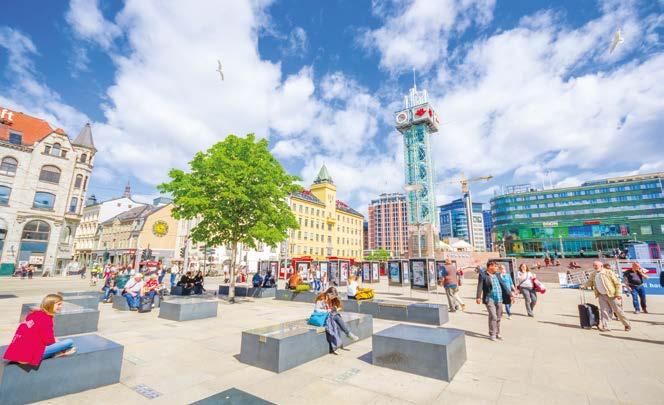
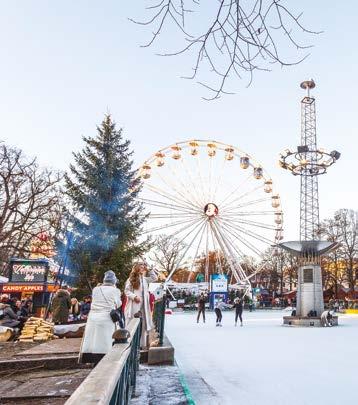
© Shutterstock
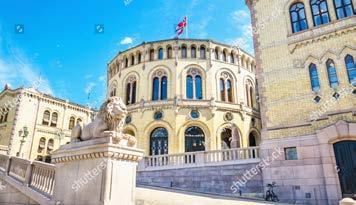
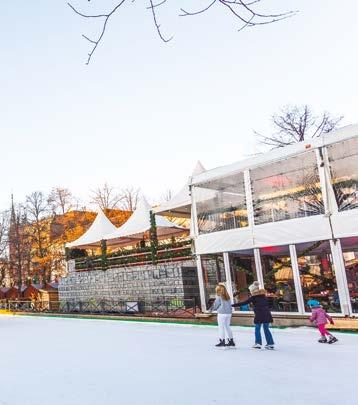
© Shutterstock

W A L K P A S T T H E B E A U T I F U L PARLIAMENT WITH ITS LION GUARDS The Norwegian parliament building is a massive H-shaped building with a distinctive semi-circle main hall. The building was designed by Swedish architect Emil Victor Langlet and was finished in 1866. The two huge stone lions guarding the building and its driveway have earned the area the nickname Løvebakken ( The Lion Hill). STORTINGSBYGNINGEN
All metro lines go through Stortinget T.
A BREAK BY THE WATER The park stretching out from the parliament, colloquially known as Spikersuppa, hosts the city’s biggest Christmas market in the winter, complete with an ice-skating rink, and in the summer, it has water features and plenty of spaces to sit down for a rest in the shade. The park is located along one of the few stretches of Karl Johan with traffic during the winter months, but in the summer, the street is closed off and cars are replaced by flowers and trees, and restaurants and cafés move their tables out onto the street for people to enjoy their food in the sun. SPIKERSUPPA
G E T A G L I M P S E O F N O RW E G I A N C U LT U R A L HISTORY AT THE NATIONAL THEATRE Across the park from the Parliament is the equally impressive Nationaltheatret (the National Theatre), which has its own metro station, Nationaltheatret T. Unchanged since it opened in 1899, the facade in yellow brick with granite details was built in a mix between Neo-classicist and Neo-Renaissance style. Often considered Henrik Ibsen’s theatre, Nationaltheatret has staged Ibsen’s plays almost every year since its inauguration and is also host to the biennial International Ibsen Festival. NATIONALTHEATRET
Nationaltheatret is served by all metro lines at Nationaltheatret T, tram # 13 and 19 at Nationaltheateret tram stop, bus # 54, 31, 30, 81 and 32 at Nationaltheatret bus stop, and several local and regional trains, as well as the airport express train at Nationaltheatret train station (connected to the metro station).
V I S I T T H E O L D F O R T R E S S W I T H ITS CENTURIES OF HISTORY When walking down to the fjord from the City Hall, turn left and head to the fortress on your left. Akershus Castle and Fortress is a perfect place for a stroll on the historic grounds, with pavements built for horses to make strolling that bit easier. Bring a book and sit down on the wall facing the fjord, with a smoothie or coffee to go, while watching the cruise ships and sailboats float by below you. Originally built around 1299, the fortress was later rebuilt as a Renaissance royal castle with a surrounding bastion. Over the centuries, a besiege has been attempted several times, mainly by Swedish forces. Since the late 1800s, it has mainly been used by the military, though at one point it was also used as a prison. While still a military area, the fortress is open to the public daily, and guided tours are available in the summer. AKERSHUS FESTNING
Tram #12 and buses 30, 31, 32, 81, 54 and 70 stop near Akershus Festning.
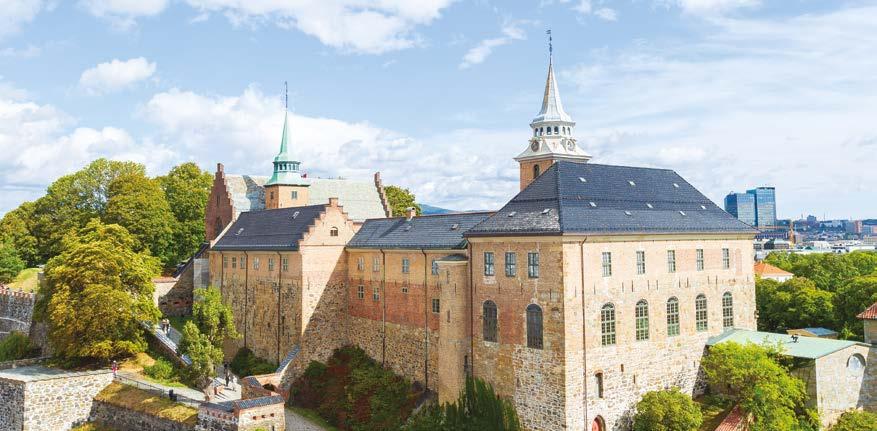
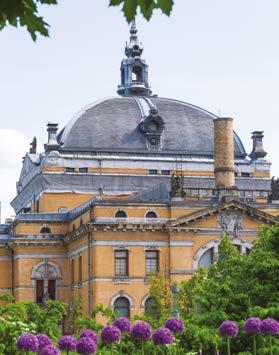
© Didrick Stenersen
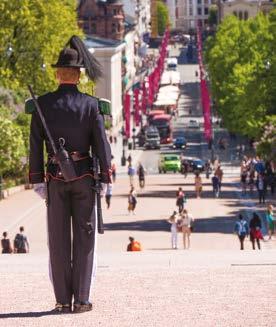
Akershus. © Didrick Stenersen

Akershus. © Didrick Stenersen
© Didrick Stenersen
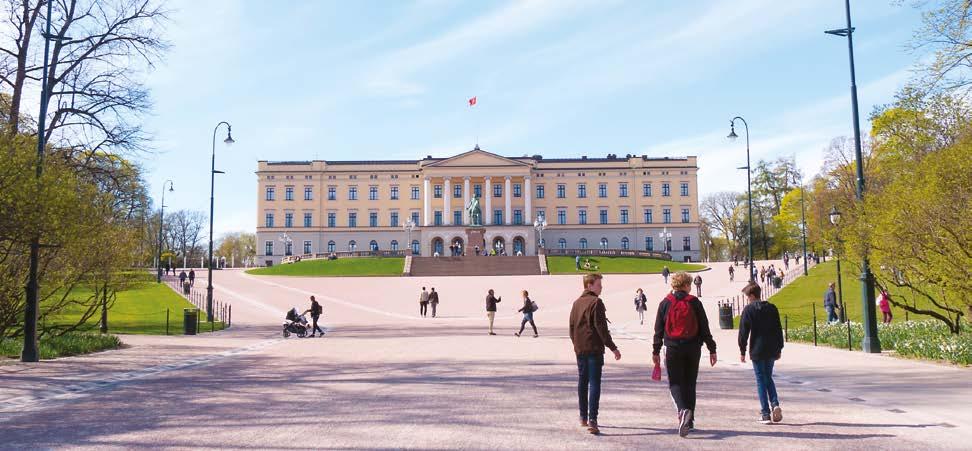
S T R O L L T O T H E R O Y A L P A L A C E A N D T H R O U G H T H E P A L A C E G A R D E N S Nationaltheatret T and Paleet Shopping Centre across the street mark the end of Karl Johan, but keep walking in the same direction, as up the hill you’ll find the Royal Palace, surrounded by the palace gardens. The palace, finished in 1849, was built in the Neo-classicist style and designed by Danish-born architect Hans Ditlev Franciscus Linstow. The palace is the official residence of the current Norwegian monarch, but unlike Buckingham Palace and similar royal residences across Europe, the Norwegian Royal Palace has no fences and gates. Instead, the entrance faces a large square, which is open to the public. Guided tours of the palace take place in the summer months, and the Royal Family gathers on the front balcony every 17 May (Norway’s National Day) to greet the public and children’s parade. The surrounding palace park is open 24/7 and contains art features, ponds and pathways leading to other parts of the city. It’s popular amongst locals who go there to sunbathe, have picnics, study or exercise. ROYAL PALACE
From the palace, you can either walk up to Bogstadveien, one of the more prominent shopping streets in Oslo, ending up at Majorstuen near the famous sculpture park Vigelandsparken, or walk back down towards Nationaltheatret and then turn right towards the Aker Brygge wharf. On the way, you’ll pass Oslo Rådhus (Oslo City Hall) with its red-brick facade and characteristic towers. This is the venue of the Nobel Peace Prize, which is awarded annually, and if you pass by on the hour, you might be treated to a performance by its glockenspiel, playing surprisingly varied songs, ranging from David Bowie and Motörhead to Edvard Grieg. The steps facing the fjord are popular among young people who go skateboarding amongst the statues and columns. At Rådhusplassen Square, you might stumble across a giant outdoor concert, a street festival or a sports event. The majority of events here are free of charge, but watch out for the trams cutting straight through the square – they’re quiet, and fast. OSLO CITY HALL
© Didrick Stenersen
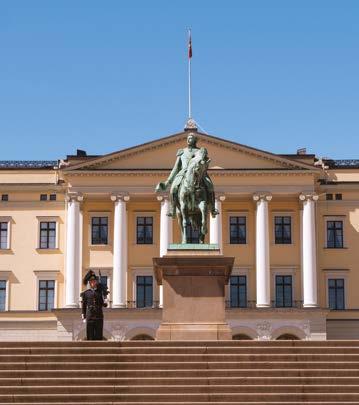
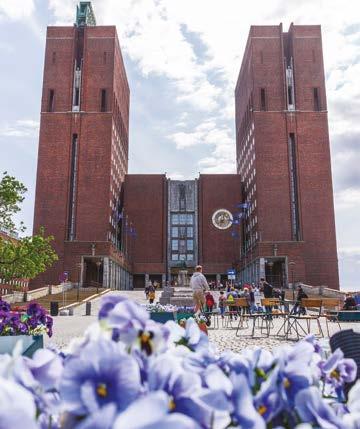
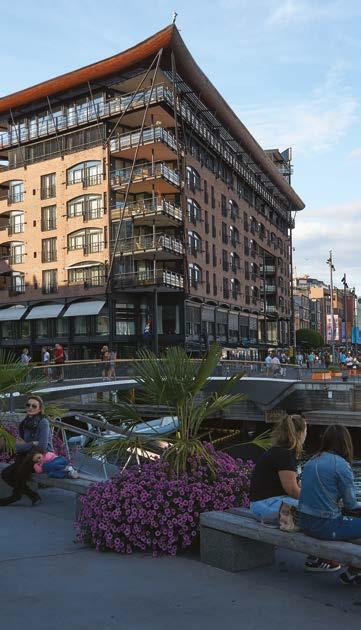
Aker Brygge Reinhard.
W A L K A L O N G T H E H A R B O U R Walk along the harbour of Aker Brygge towards Tjuvholmen while taking in the views of the fjord and the Akershus fortress, the ferries bringing people to and from the islands, and the beautiful archipelago. Sit down on the wooden steps leading down to the water and enjoy a cone of ice cream and a coffee in the sun before checking out the nearby galleries and museums. But don’t feed the seagulls; they might not leave you alone afterwards. Aker Brygge also boasts a high-end shopping centre, with shops, galleries and restaurants. A K E R B R Y G G E
Tram # 12 stops at Aker Brygge.
T H E B I G G E S T A R T M U S E U M IN THE NORDICS In 2021, the biggest art museum in the Nordics, the new National Museum, will open in the area and feature both older and contemporary art, architecture and design. The building is currently under construction, and though it’s currently looking more like a giant concrete box, completely dwarfing the tiny Nobel Peace Center located in front of it, the building will be lighting up the Oslo night once it’s completed. NATIONAL MUSEUM
Tram # 12 stops at Aker Brygge.
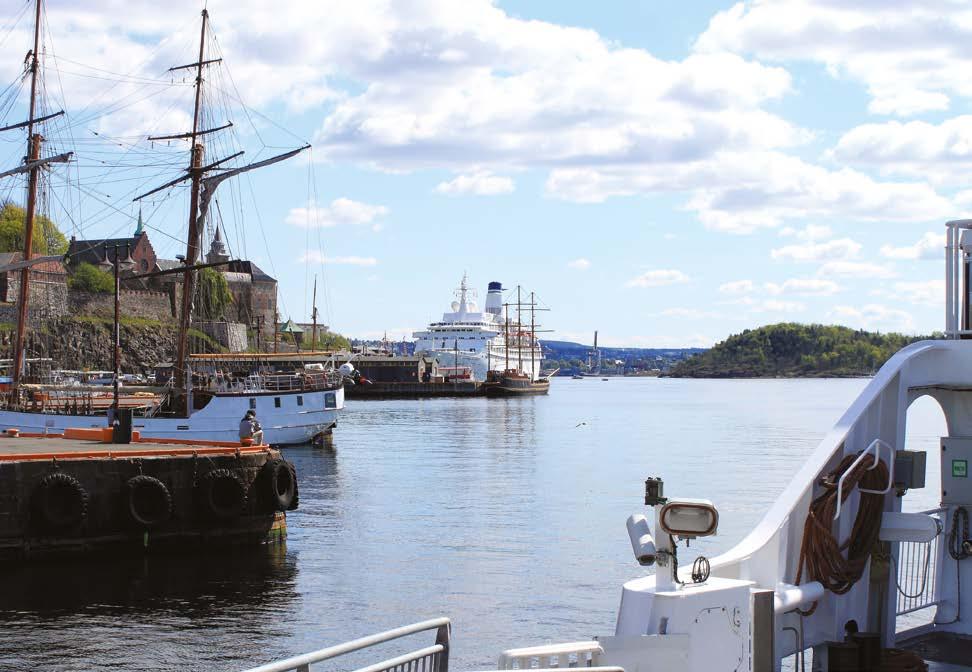
CONTINUE ALONG THE DOCKS Once you’ve got your strength back, continue along the docks to the newly redeveloped Tjuvholmen, where you’ll find futuristic and expensive buildings, quaint canals and a fjord walk lining the island. Overlooking it all is the impressive Astrup Fearnley Museet, a private museum of contemporary art. First opened in 1993, the museum moved to its current home, designed by architect Renzo Piano, in 2012. Varying parts of the Astrup Fearnley collection are always on display, with works from among others Damien Hirst and Jeff Koons as permanent pieces. There are also changing exhibitions by Norwegian and international contemporary artists. The museum grounds are another popular feature, with a sculpture park also designed by Piano, as well as a city beach open to the public. TJUVHOLMEN
Tram # 12 and buses # 54, 32 and 81 stop near Filipstad.
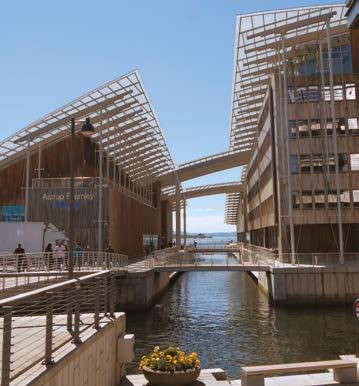
Astrup Fearnley Museum. © Vegard Kleven

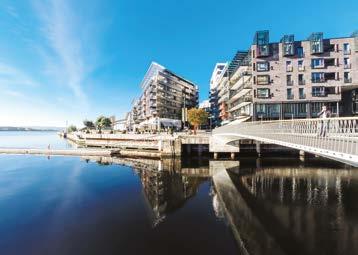
Tjuvholmen.
© Didrick Stenersen

Fun fact When travelling on public transport, Norwegians’ respect for personal space can get quite comical. They will usually avoid sitting down on unoccupied seats next to a stranger, unless there are no doubles available anywhere. At bus stops, it’s not unusual to see people in line waiting one metre apart.
© Tord Baklund
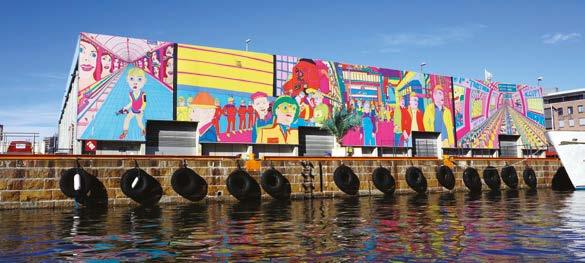
W I T N E S S T H E D E V E L O P M E N T O F A BRAND-NEW URBAN NEIGHBOURHOOD Continue your stroll along the fjord walk towards Filipstad and enjoy the canals, the architecture and art, or stop by one of the many high-end restaurants in the area. Filipstad is still being redeveloped and will eventually be a brand-new urban district, but it already boasts Skur 13, an indoor skate park where you can bring your own gear or hire a limited range of equipment for free. Filipstad is also the home of Oslotreet (the Oslo Tree), a 14-metre-tall tree complete with 125,000 LED lamps lighting up the Oslo night. The tree is on loan from Stein Erik Hagen to Oslo City, designed by Alexander Green, and previously displayed as the Tree of Ténéré at Nevada’s Burning Man festival. FILIPSTAD










